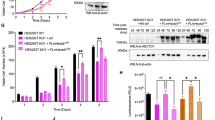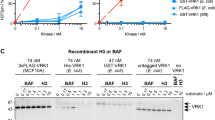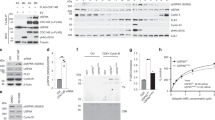Abstract
When vertebrate cells exit mitosis various cellular structures are re-organized to build functional interphase cells1. This depends on Cdk1 (cyclin dependent kinase 1) inactivation and subsequent dephosphorylation of its substrates2,3,4. Members of the protein phosphatase 1 and 2A (PP1 and PP2A) families can dephosphorylate Cdk1 substrates in biochemical extracts during mitotic exit5,6, but how this relates to postmitotic reassembly of interphase structures in intact cells is not known. Here, we use a live-cell imaging assay and RNAi knockdown to screen a genome-wide library of protein phosphatases for mitotic exit functions in human cells. We identify a trimeric PP2A–B55α complex as a key factor in mitotic spindle breakdown and postmitotic reassembly of the nuclear envelope, Golgi apparatus and decondensed chromatin. Using a chemically induced mitotic exit assay, we find that PP2A–B55α functions downstream of Cdk1 inactivation. PP2A–B55α isolated from mitotic cells had reduced phosphatase activity towards the Cdk1 substrate, histone H1, and was hyper-phosphorylated on all subunits. Mitotic PP2A complexes co-purified with the nuclear transport factor importin-β1, and RNAi depletion of importin-β1 delayed mitotic exit synergistically with PP2A–B55α. This demonstrates that PP2A–B55α and importin-β1 cooperate in the regulation of postmitotic assembly mechanisms in human cells.
This is a preview of subscription content, access via your institution
Access options
Subscription info for Japanese customers
We have a dedicated website for our Japanese customers. Please go to natureasia.com to subscribe to this journal.
Buy this article
- Purchase on SpringerLink
- Instant access to full article PDF
Prices may be subject to local taxes which are calculated during checkout





Similar content being viewed by others
References
Morgan, D. O. The cell cycle: principles of control. (Oxford University Press, 2007).
Queralt, E. & Uhlmann, F. Cdk-counteracting phosphatases unlock mitotic exit. Curr. Opin. Cell Biol. 20, 661–668 (2008).
Bollen, M., Gerlich, D. W. & Lesage, B. Mitotic phosphatases: from entry guards to exit guides. Trends Cell Biol. 19, 531–541 (2009).
Trinkle-Mulcahy, L. & Lamond, A. I. Mitotic phosphatases: no longer silent partners. Curr. Opin. Cell Biol. 18, 623–631 (2006).
Wu, J. Q. et al. PP1-mediated dephosphorylation of phosphoproteins at mitotic exit is controlled by inhibitor-1 and PP1 phosphorylation. Nat. Cell Biol. 11, 644–651 (2009).
Mochida, S., Ikeo, S., Gannon, J. & Hunt, T. Regulated activity of PP2A–B55δ is crucial for controlling entry into and exit from mitosis in Xenopus egg extracts. EMBO J. 28, 2777–2785 (2009).
Stegmeier, F. & Amon, A. Closing mitosis: the functions of the Cdc14 phosphatase and its regulation. Annu. Rev. Genet. 38, 203–232 (2004).
Berdougo, E., Nachury, M. V., Jackson, P. K. & Jallepalli, P. V. The nucleolar phosphatase Cdc14B is dispensable for chromosome segregation and mitotic exit in human cells. Cell Cycle 7, 1184–1190 (2008).
Gruneberg, U., Glotzer, M., Gartner, A. & Nigg, E. A. The CeCDC-14 phosphatase is required for cytokinesis in the Caenorhabditis elegans embryo. J. Cell Biol. 158, 901–914 (2002).
Mailand, N. et al. Deregulated human Cdc14A phosphatase disrupts centrosome separation and chromosome segregation. Nat. Cell. Biol. 4, 317–322 (2002).
Mocciaro, A. et al. Vertebrate cells genetically deficient for Cdc14A or Cdc14B retain DNA damage checkpoint proficiency but are impaired in DNA repair. J. Cell Biol. 189, 631–639 (2010).
Nishiyama, T., Yoshizaki, N., Kishimoto, T. & Ohsumi, K. Transient activation of calcineurin is essential to initiate embryonic development in Xenopus laevis. Nature 449, 341–345 (2007).
Mochida, S. & Hunt, T. Calcineurin is required to release Xenopus egg extracts from meiotic M phase. Nature 449, 336–340 (2007).
Mayer-Jaekel, R. E. et al. The 55 kd regulatory subunit of Drosophila protein phosphatase 2A is required for anaphase. Cell 72, 621–633 (1993).
Axton, J. M., Dombradi, V., Cohen, P. T. & Glover, D. M. One of the protein phosphatase 1 isoenzymes in Drosophila is essential for mitosis. Cell 63, 33–46 (1990).
Doonan, J. H. & Morris, N. R. The bimG gene of Aspergillus nidulans, required for completion of anaphase, encodes a homolog of mammalian phosphoprotein phosphatase 1. Cell 57, 987–996 (1989).
Janssens, V., Longin, S. & Goris, J. PP2A holoenzyme assembly: in cauda venenum (the sting is in the tail). Trends Biochem. Sci. 33, 113–121 (2008).
Neumann, B. et al. Phenotypic profiling of the human genome by time-lapse microscopy reveals cell division genes. Nature 464, 721–727 (2010).
Steigemann, P. et al. Aurora B-mediated abscission checkpoint protects against tetraploidization. Cell 136, 473–484 (2009).
Dultz, E. et al. Systematic kinetic analysis of mitotic dis- and reassembly of the nuclear pore in living cells. J. Cell Biol. 180, 857–865 (2008).
Held, M. et al. CellCognition: time-resolved phenotype annotation in high-throughput live cell imaging. Nat. Methods doi: 10.1038/nmeth.1486 (in the press).
Schaub, B. E., Berger, B., Berger, E. G. & Rohrer, J. Transition of galactosyltransferase 1 from trans-Golgi cisterna to the trans-Golgi network is signal mediated. Mol. Biol. Cell 17, 5153–5162 (2006).
Leonhardt, H. et al. Dynamics of DNA replication factories in living cells. J. Cell Biol. 149, 271–280 (2000).
Lee, T. H., Turck, C. & Kirschner, M. W. Inhibition of cdc2 activation by INH/PP2A. Mol. Biol. Cell 5, 323–338 (1994).
Potapova, T. A. et al. The reversibility of mitotic exit in vertebrate cells. Nature 440, 954–958 (2006).
Skoufias, D. A., Indorato, R. L., Lacroix, F., Panopoulos, A. & Margolis, R. L. Mitosis persists in the absence of Cdk1 activity when proteolysis or protein phosphatase activity is suppressed. J. Cell Biol. 179, 671–685 (2007).
Poser, I. et al. BAC TransgeneOmics: a high-throughput method for exploration of protein function in mammals. Nat. Methods 5, 409–415 (2008).
Harel, A. & Forbes, D. J. Importin-β: conducting a much larger cellular symphony. Mol. Cell 16, 319–330 (2004).
Guo, H. & Damuni, Z. Autophosphorylation-activated protein kinase phosphorylates and inactivates protein phosphatase 2A. Proc. Natl Acad. Sci. USA 90, 2500–2504 (1993).
Mayer-Jaekel, R. E. et al. Drosophila mutants in the 55 kDa regulatory subunit of protein phosphatase 2A show strongly reduced ability to dephosphorylate substrates of p34cdc2. J. Cell Sci. 107, 2609–2616 (1994).
Longin, S. et al. Selection of protein phosphatase 2A regulatory subunits is mediated by the C terminus of the catalytic Subunit. J. Biol. Chem. 282, 26971–26980 (2007).
Shi, Y. Serine/threonine phosphatases: mechanism through structure. Cell 139, 468–484 (2009).
Huang, H. C., Shi, J., Orth, J. D. & Mitchison, T. J. Evidence that mitotic exit is a better cancer therapeutic target than spindle assembly. Cancer Cell 16, 347–358 (2009).
Xu, Y., Chen, Y., Zhang, P., Jeffrey, P. D. & Shi, Y. Structure of a protein phosphatase 2A holoenzyme: insights into B55-mediated Tau dephosphorylation. Mol. Cell 31, 873–885 (2008).
Schmitz, M. H. & Gerlich, D. W. Automated live microscopy to study mitotic gene function in fluorescent reporter cell lines. Methods Mol. Biol. 545, 113–134 (2009).
Amniai, L. et al. Alzheimer disease specific phosphoepitopes of Tau interfere with assembly of tubulin but not binding to microtubules. FASEB J. 23, 1146–1152 (2009).
Shacter-Noiman, E. & Chock, P. B. Properties of a M r = 38, 000 phosphoprotein phosphatase. Modulation by divalent cations, ATP, and fluoride. J. Biol. Chem. 258, 4214–4219 (1983).
Waelkens, E., Goris, J. & Merlevede, W. Purification and properties of polycation-stimulated phosphorylase phosphatases from rabbit skeletal muscle. J. Biol. Chem. 262, 1049–1059 (1987).
Gregan, J. et al. Tandem affinity purification of functional TAP-tagged proteins from human cells. Nat. Protoc. 2, 1145–1151 (2007).
Acknowledgements
The authors thank F. Uhlmann and B. Novak for critical comments on the manuscript. We thank S. Maar, the ETHZ Light Microscopy Centre (LMC), the ETHZ RNAi Screening Centre (RISC), M. Augsburg (The Max Planck Institute of Molecular Cell Biology and Genetics; MPI-CBG), M. Leuschner (MPI-CBG) and A. Ssykor (MPI-CBG) for technical assistance. We thank U. Kutay (ETHZ) for anti-importin-β1 and anti-nucleolin antibodies, J. Rohrer (University of Zurich) for providing GalT–eGFP plasmid, J. Ellenberg (EMBL, Heidelberg) for IBB–eGFP plasmid, M.C. Cardoso (Technical University, Darmstadt) for eGFP–PCNA plasmid and Sanofi Aventis and the National Cancer Institute for providing flavopiridol. This work was supported by Swiss National Science Foundation (SNF) research grant 3100A0-114120, SNF ProDoc grant PDFMP3_124904, a European Young Investigator (EURYI) award of the European Science Foundation to D.W.G., a MBL Summer Research Fellowship by the Evelyn and Melvin Spiegel Fund to D.W.G., a Roche Ph.D. fellowship to M.H.A.S. and a Mueller fellowship of the Molecular Life Sciences Ph.D. programme Zurich to M.H. M.H. and M.H.A.S. are fellows of the Zurich Ph.D. programme in Molecular Life Sciences. V.J. and J.G. were supported by grants of the 'Geconcerteerde OnderzoeksActies' of the Flemish government, the 'Interuniversitary Attraction Poles' of the Belgian Science Policy P6/28 and the 'Fonds voor Wetenschappelijk Onderzoek-Vlaanderen'. A.I.L. is a Wellcome Trust Principal Research Fellow. A.A.H. acknowledges funding by the Max Planck Society, MitoCheck (the EU-FP6 integrated project), and a BMBF (Bundesministerium für Bildung and Forschung) grant, DiGtoP (01GS0859). Work in the groups of K.M. and J.M.P. was supported by MitoCheck (the EU-FP6 integrated project), Boehringer Ingelheim, the GEN-AU programme of the Austrian Federal Ministry of Science and Research (Austrian Proteomics Platform III), MeioSys within the Seventh Framework Programme of the European Commission and by Chromosome Dynamics, which is funded by the Austrian Science Foundation (FWF).
Author information
Authors and Affiliations
Contributions
M.H.A.S. performed all experiments, except the mass spectrometry and in vitro phosphatase assays, and wrote part of the paper. M.H. implemented software for automated imaging and data analysis. V.J., E.I. and J.G. performed in vitro phosphatase assays and B55α phospho-mutant analysis. J.H. and J.M.P. designed and performed PP2A purification. K.M. and O.H. performed mass spectrometry. L.T.M. and A.I.L. compiled the phosphatase screening library. I.P. and A.A.H. generated the cell lines stably expressing LAP-tagged PP2A subunits. D.W.G. conceived the project, designed the screening strategy and wrote the paper.
Corresponding author
Ethics declarations
Competing interests
The authors declare no competing financial interests.
Supplementary information
Supplementary Information
Supplementary Information (PDF 1452 kb)
Supplementary Information
Supplementary Information Movie 1 (MOV 9132 kb)
Supplementary Information
Supplementary Information Movie 2 (MOV 963 kb)
Supplementary Information
Supplementary Information Movie 3 (MOV 1127 kb)
Supplementary Information
Supplementary Information Movie 4 (MOV 1127 kb)
Supplementary Information
Supplementary Information Movie 5 (MOV 1288 kb)
Supplementary Information
Supplementary Information Movie 6 (MOV 930 kb)
Supplementary Information
Supplementary Information Movie 7 (MOV 2989 kb)
Supplementary Information
Supplementary Information Movie 8 (MOV 2989 kb)
Supplementary Information
Supplementary Information Movie 9 (MOV 412 kb)
Supplementary Information
Supplementary Information Movie 10 (MOV 412 kb)
Supplementary Information
Supplementary Information Movie 11 (MOV 1127 kb)
Supplementary Information
Supplementary Information Movie 12 (MOV 930 kb)
Supplementary Information
Supplementary Information Movie 13 (MOV 412 kb)
Rights and permissions
About this article
Cite this article
Schmitz, M., Held, M., Janssens, V. et al. Live-cell imaging RNAi screen identifies PP2A–B55α and importin-β1 as key mitotic exit regulators in human cells. Nat Cell Biol 12, 886–893 (2010). https://doi.org/10.1038/ncb2092
Received:
Accepted:
Published:
Issue Date:
DOI: https://doi.org/10.1038/ncb2092
This article is cited by
-
A mitotic chromatin phase transition prevents perforation by microtubules
Nature (2022)
-
Targeting protein phosphatases for the treatment of inflammation-related diseases: From signaling to therapy
Signal Transduction and Targeted Therapy (2022)
-
Inhibition of Kpnβ1 mediated nuclear import enhances cisplatin chemosensitivity in cervical cancer
BMC Cancer (2021)
-
Regulation of PP2A, PP4, and PP6 holoenzyme assembly by carboxyl-terminal methylation
Scientific Reports (2021)
-
The G2-to-M transition from a phosphatase perspective: a new vision of the meiotic division
Cell Division (2020)



